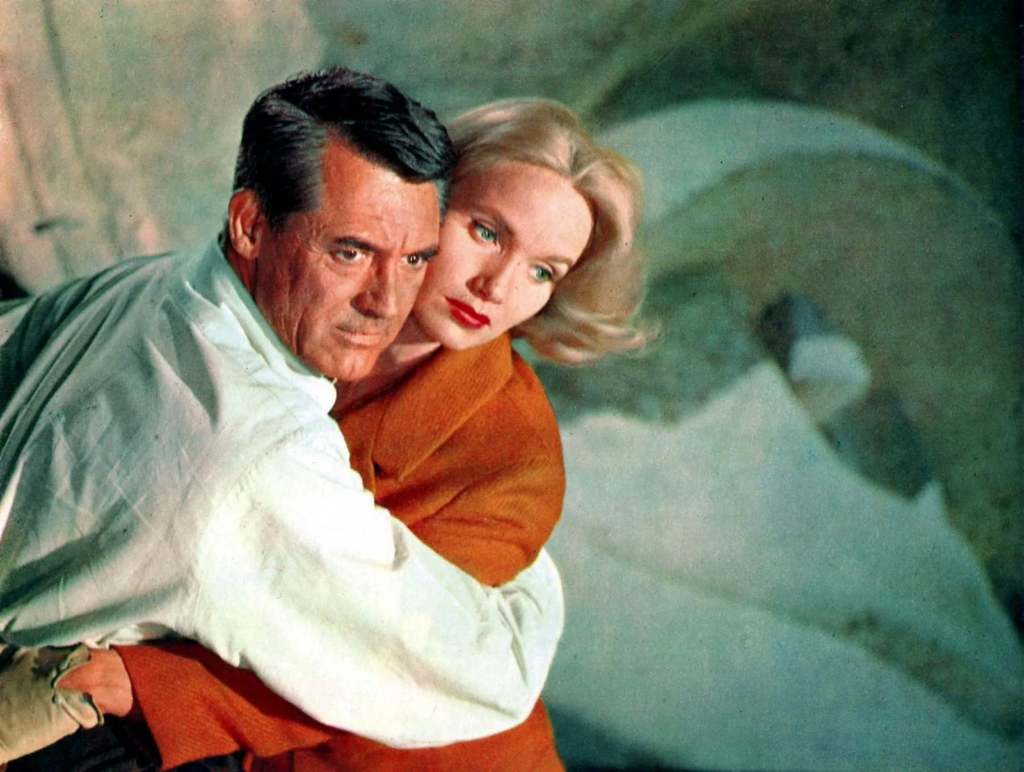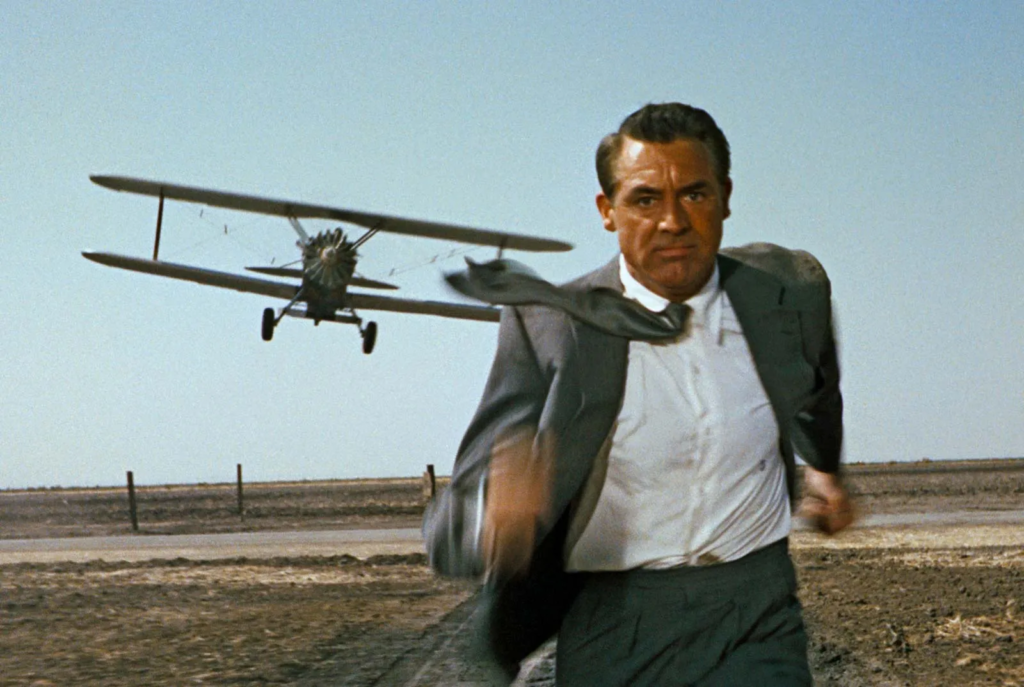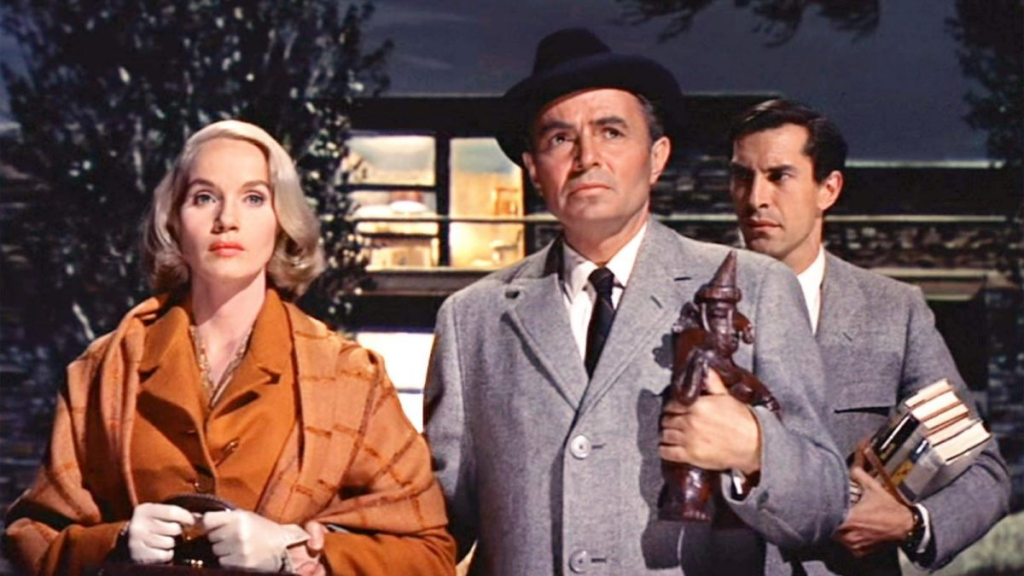Director: Alfred Hitchcock
Writer: Ernest Lehman
Stars: Cary Grant, Eva Marie Saint, James Mason
Synopsis: A New York City advertising executive goes on the run after being mistaken for a government agent by a group of foreign spies, and falls for a woman whose loyalties he begins to doubt.
We’re used to seeing cramped, claustrophobic tension in Alfred Hitchcock films with a handful of people around in any given scene. North by Northwest, from the first build of Bernard Hermann’s tremendously frenetic score, shows us New York City as a place absolutely covered in people. Every inch of sidewalk is a flowing river of humanity, the bumper to bumper cars never seem to get anywhere, but are always in a constant block of motion; buildings spew and consume people in a near constant flow giving us a startling grip of our own anonymity in the grand scheme of humanity. That awareness turns into anxiety as we watch a man’s very persona called into question.

Ernest Lehman’s script hums with the fear of this scenario. We’ve all had a situation in which we were perceived or accused of being someone or doing something we didn’t do, but the extreme to which North by Northwest takes this brings the fear to an entirely new level. Our entire life and being could be completely undone by a hand gesture seen across a room. No matter what Roger Thornhill (Cary Grant) says or does, he will be persecuted. Even when he thinks he’s safely out, when he decides he’s going to do a bit of digging on his own, he just falls ever deeper into the morass of geopolitical espionage. The script adds layer upon layer to the subterfuge, threading each needle carefully and stitching it all together in a sinister quilt. It’s an utterly terrifying concept and may be the most devious plot Hitchcock has ever taken on.
The complicated plot doesn’t lack the Hitchcock visual flair either. From wide shots of the cavernous U.N. building lobby, to a bird’s eye view of Roger exiting the building like an ant on a toy model, Hitchcock and frequent collaborator, cinematographer Robert Burks, build a visual language that is unparalleled. Their crowning achievement as collaborators has to be North by Northwest‘s most indelible and incomparable scene, the crop duster chase.

As Roger stands in the almost literal middle of nowhere, chasing a lead from Eve’s (Eva Marie Saint) supposed conversation with the real George Kaplan, he starts to suspect he’s been led astray. It’s not until he speaks with a man who he assumes is Kaplan that he realizes he has been set up. The man points out that the crop dusting plane that has been in the background of the scene the whole time isn’t actually dusting any crops. It’s then that the plane turns and makes its true purpose known. There are a couple of strafes by the plane before Hitchcock sets up a shot that will thrill people long into the future. Roger sees the plane as it makes its diving run. He turns and rather than a cut or a pan, Roger runs forward as the camera dollies backward as if the plane chases Roger and Roger chases the camera. The plane and Roger are captured in the same shot, the plane growing closer, until Roger falls in order to avoid the bullets coming at him from the plane’s gun.
That’s only a piece of the truly thrilling and brilliant sequence, capped by Roger running into the road to stop a fuel tanker. Editor George Tomasini struts his incredible skill as he cuts between shots of Roger in the road with the truck coming for him, then the truck hitting the brakes, and finally Roger falling backward landing somewhat safely under the truck. All of Tomasini’s edits show the power of the position and how well the skill can craft a beautiful work of art.
As inventive and mind blowing as that crop duster sequence is, it does highlight that the two major set pieces of North by Northwest, the other being the climax on Mt. Rushmore are utter nonsense in terms of plot. Why would a traitorous spy leave the assassination of his rival to such incomprehensible means? Why would someone launch their international escape from landlocked South Dakota? The only answers that could be are that these sequences make for exciting and excellent set pieces. Otherwise they’re fluff, unfortunately like much of the plot involving Eve Kendall (Eva Marie Saint).
It’s obvious that without the strictures placed on films under the Hays Code that Eve would have been a much more interesting and nuanced character. She definitely starts off that way, but slowly peters out to another of Hitchcock’s blonde damsels in distress by the end. Eve’s introduction is bold. She manipulates the situation so that Roger ends up sitting at her table and she proceeds to bluntly and very effectively seduce him. She takes him back to her private car and gently guides and switches their positions against the wall, so she’s pinning him with her kiss in a dominant position. This bold sexuality is exciting to see in a film like this where, previously, the man is always the aggressor. It’s a pity then that this character could only have so much confidence for one subterfuge at a time. Her true motivations or feelings are too muddy and the grand romance we are to believe she’s experiencing rings so false. It serves the plot to keep Roger in her orbit, but one wonders what could have been if she were allowed to have taken the reins more fully.

In spite of a few flaws, North by Northwest remains an unqualified triumph. It’s got some of the best humor, dark and otherwise, in any Hitchcock film and it never lags for a second of its run time. North by Northwest is a top notch thriller that demands repeat viewings if only to try and piece the plot together again for what feels like the first time, every time.





